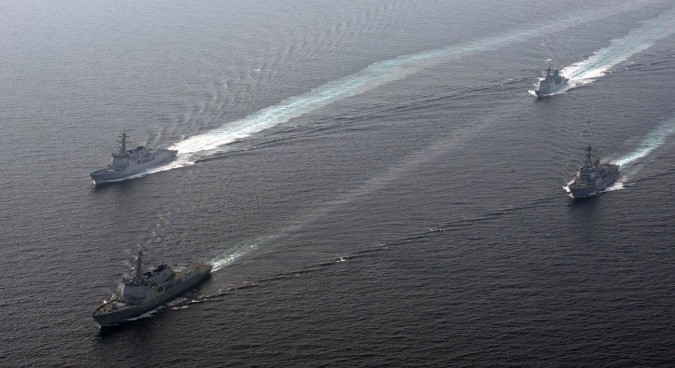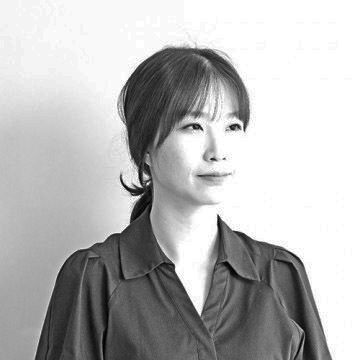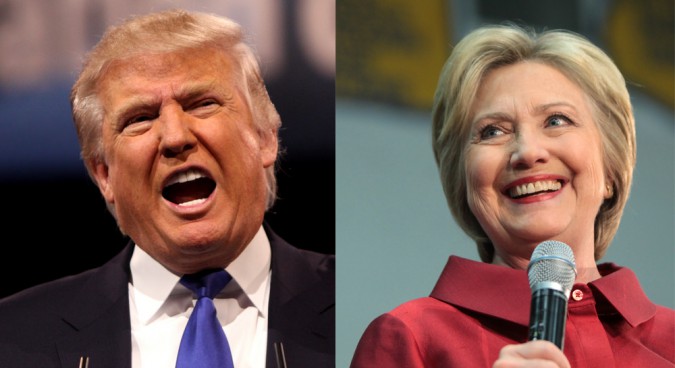Clinton and Trump. I must admit that even I am getting very weary of the press reporting of these two very unliked and unlikeable people.Usually, (with the exception of Nixon, notably) the most likeable human wins the US Presidential elections but there's really no one, except the Greens Party lady. At least she has wise policies and is interested in making the US a better place for Americans. I'd vote for her.
U.S., ROK showcase anti-sub capabilities in show of force
First time U.S.- ROK maritime drills conducted outside of the routine exercise cycle
The U.S. and Republic of Korea navies (ROKN) joined forces on Monday to conduct combined maritime exercises in the East Sea to demonstrate their anti-submarine warfare (ASW) and precision strike capabilities two weeks after North Korea’s fifth nuclear test.
The combined maritime drills were undertaken outside of the routine exercise cycle “for the first time” in a show of force against the North’s recent and continuing provocations, the Republic of Korea (ROK) Fleet and Commander, U.S. Naval Forces Korea (CNFK) said in a press release.
The U.S. and the South hold joint military exercises such as Key Resolve, Foal Eagle, and Ulchi Freedom Guardian (UFG) on a yearly basis.
The operation saw the U.S. and South Korean navies join forces to identify and track an enemy submarine in various scenarios through ASW, and to carry out pinpoint strikes against enemy forces.
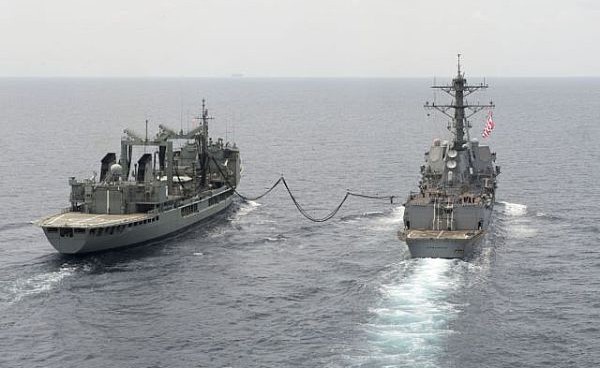
The guided-missile destroyer USS Spruance (DDG 111, Right) takes on a fuel line from the Australian oiler HMAS Success (OR 304) during a refueling at South China sea (July 27, 2016) | Credit: U.S. Navy
USS Spruance (DDG 111) – an Arleigh Burke-class guided-missile destroyer – and Aegis destroyers Yulgok-yiyi from the South were involved. The P-3 Orion land-based maritime patrol, ASW helicopters Lynx, and submarines also joined the drills.
“This combined maritime operation is another example of the broad range of capabilities the alliance has to confront North Korea’s unacceptable behavior and the threat they pose to the stability on the Korean Peninsula, and the region,” General Vincent Brooks, U.S. Forces Korea (USFK) Commander said in a written statement released by USFK.
Two B-1B Lancers, U.S. supersonic nuclear-capable bombers, were recently dispatched to South Korean airspace as part of a joint show of strength against Pyongyang.
Two bombers were opened up for public inspection during an air show in South Korea this Saturday and Sunday.
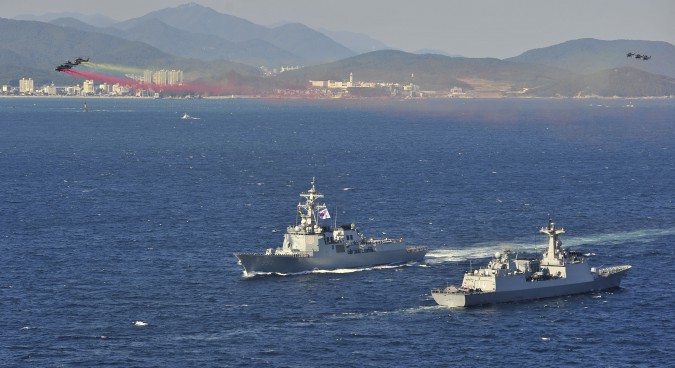
Aegis destroyers Yulgok-yiyi (Left) during fleet review (October 17, 2015) | Source: Republic of Korea Armed Forces
An expert based in South Korea said the drills were an obvious response to the North’s heightened military and nuclear threats.
“The USS Spruance destroyer has equipped with SM-3 (Standard Missile-3) which is a ship-launched anti-ballistic missile. And radar-equipped destroyer Yulgok-yiyi can detect missiles, but it doesn’t have SM-3 to shoot down the target [at high altitude],” Moon Keun-sik, the director of the Korea Defense and Security Forum (KODEF), told NK News.
Moon pointed out it was the Yulgok-yiyi and Seoae Ryu Seong-ryong destroyers (DDG 993), along with the Sejong the Great class destroyer (DDG-991), that detected the North’s long-range rocket Unha-3 test in December 12, 2012.
All three ships are armed with a version of the SM-2 missile, which can function as a makeshift lower-tier ballistic missile interceptor.
The SM-3 is designed to intercept at up to about 200 kilometers, while the SM-2 is a lower-tier interceptor. A Terminal High-Altitude Area Defense (THAAD) defense system can only intercept missiles in the terminal phase at an altitude of about 40-150 km over South Korean territory.
“…the combined military drills are aimed to detect a projectile launched from the North’s SLBM (submarine-launched ballistic missile) at an early stage [by utilizing Yulgok-yiyi] and to bring down the target [at higher tier] by using SM-3,” Moon added.
“It is expected for the U.S.-ROK alliance to conduct such training, especially faced with North Korea having a large submarine fleet,” John Grisafi, director of intelligence at NK News said. “Anti-submarine warfare (ASW) is a something of an art, though it involves a lot of science and technological methods, which requires continual practice.”
The biggest and newest known North Korean submarine is its Sinpo-class (also known as Gorae-class) vessel, and it can carry a single Pukkuksong-1 SLBM with a displacement of just 2,000 tons, previous NK News analysis indicated.
“The history of operations against the South by the North using submarines, such as the sinking of the ROK’s Cheonan in 2010, and the Gangneung submarine infiltration incident in 1996,” Grisafi added, made it likely that these exercises are will continue.
Featured Image: U.S. Forces Korea (USFK), Published on September 26th
